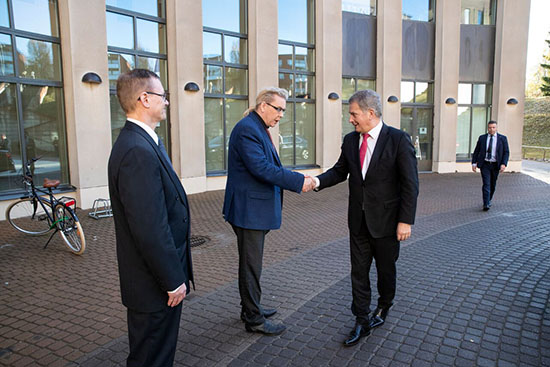Climate change must stay firmly on top of our agenda, affirmed President of the Republic of Finland Sauli Niinistö as he opened the Arctic Biodiversity Congress in Rovaniemi.
Just one day after the IPCC’s latest special report on global warming, President Niinistö emphasized the need for direct interaction with scientists to make the most advanced knowledge accessible and understandable to policymakers.
“As the IPCC report points out, the Arctic region is one of the most vulnerable systems on our planet, if and when global warming continues. On the other hand, the melting of the sea ice and other changes in the Arctic region accelerate climate change on the global scale. I have said this before: if we lose the Arctic, we lose the globe.”
Sauli Niinistö is an ardent advocate for reducing black carbon emissions.
“Black carbon is particularly relevant for the fate of the Arctic sea ice. When black carbon falls on the white ice, it immediately accelerates the melting. Its absence would have an equally immediate impact to the contrary. Cutting down black carbon emissions is the quickest way to slow down the rapid changes now occurring in the Arctic.”
President Niinistö also brought up his proposition of Finland organising a first-ever Arctic Summit. According to him, environmental issues deserve a meeting of the Arctic states on the highest political level. The President said that the discussions he has had in preparing the possible summit have given him reason for some optimism.
“Climate change may not be the best conversation starter in every capital these days, but you can still find constructive ways to address the concrete issues behind it. There is hope. We still have a chance to save the Arctic, and to save the globe. But there is no time to waste.”
Organized by the Conservation of Arctic Flora and Fauna (CAFF) and the biodiversity working group of the Arctic Council, the Arctic Biodiversity Congress has brought to Rovaniemi hundreds of stakeholders working on the conservation of Artic biodiversity. Scientists, indigenous peoples, policy-makers, government officials, industry, students and civil society share their knowledge in order to conserve the Arctic ecosystem.
The Arctic Biodiversity Congress was established to address the Arctic Biodiversity Assessment, a region-wide assessment of threats to Arctic biodiversity conducted by the CAFF working group of the Arctic Council.
Six main themes guide the flow of the Rovaniemi Congress - climate change; ecosystem-based management; mainstreaming biodiversity; addressing individual stressors on biodiversity; identifying and safeguarding important areas for biodiversity; and improving knowledge and public awareness. They were identified in the ABA policy recommendations.
This week the city of Rovaniemi will be full of people dedicated to the Arctic environment. In addition to the Arctic Biodiversity Congress, the Arctic Ministers of the Environment and the representatives of the Arctic Indigenous Peoples will have their meeting starting on Thursday, October 11.

Photos: Top of page: Anna Morottaja performed during the opening session. Photo by IISD/ENB, Mike Muzurakis
End of page: Director of the Arctic Centre Timo Koivurova and the Rector of the University of Lapland Mauri Ylä-Kotola welcomed Sauli Niinistö to the Arctic Centre. Photo by Kaisa Sirén/Arctic Centre.